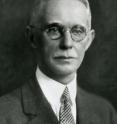A chemist's discovery breathes new life into the old South
One chemist plus one new scientific discovery yields. . . an economic and environmental miracle. Almost overnight, a whole new industry springs up and breathes life into an economically-devastated region of the country. It creates millions of new jobs and pumps billions of dollars into the economy. Thousands of miles away, the discovery helps avert the potential decimation of old growth forests, where millions of spruce, fir, poplar, and other trees were being cut each year. "That scenario actually happened and it is a history lesson about the value of chemistry research to the real world economy," Georgia chemist Donald Hicks, Ph.D., said here today at the 238th National Meeting of the American Chemical Society. Hicks was describing how a little-known discovery in 1932 by Georgia chemist Charles Holmes Herty engendered the huge pulp and paper industry in the southeastern United States. In doing so, it revived the South's economy, devastated by the Great Depression and damage to its mainstay cotton crop by the boll weevil.
Herty, then 64, turned conventional scientific wisdom on its ear by showing that high quality paper could be made from rapidly renewable southern pine. At the time, paper for newspapers and other applications that required white paper was made from slow growth trees in the North. Demand was slowly decimating northern forests.
"Herty planned to use fast growing southern pine trees to create the very high value commodity white paper as well as cellulose and rayon," Hicks explained. "But when he said that he wanted to use a sulfite solution chemical pulping process, every expert in the paper-making field said it couldn't be done because of too much sticky resin in these trees."
All of the experts were wrong. Herty's innovative theory, which proved to be valid, was that older pine trees might secrete resin as a defense mechanism, and, thus, young pines might contain much less resin.
"Herty succeeded, driven by an idea he believed in and by the nobility of the cause of helping the poor economy of his native South, and with no personal financial investment gain ever coming from his work," Hicks said. Fifteen southern pulp and paper mills were reported built from 1935 to 1940, resulting in thousands of new jobs.
Hicks, a retired chemistry professor with Georgia State University, said that the Savannah, Ga., mill alone created 4,400 jobs, and 70 years later, 11 percent of the jobs in six states were connected to this industry. Paper mills proved the southern USA industrial potential, and led to the region's rapid industrialization by the 1950s. Herty's 1932 paper-making efforts also created the tree farming industry with 4.5 million citizens involved in 2002, and decimation of the great northern hardwood forests was slowed dramatically.
To test his theory, Herty performed chemical analyses on trees of varying ages to prove that pines less than 20 years old had no more sticky resin than old northern trees used then for making white paper. He used a well-known sulfite solution pulping process he had heard about 30 years earlier.
Based on common chemistry separation principles, the analysis procedure involved first dissolving the resin in a weighed sawdust sample into a volatile organic solvent that did not dissolve other wood components. After filtering and gently evaporating the volatile solvent, the resin containing residue was weighed and its percentage calculated. This chemical analysis provided the "eureka moment" that created tens of thousands of pulp and paper industry jobs in the depression era South.
Source: American Chemical Society
Other sources
- A chemist's discovery breathes new life into the old Southfrom Science BlogTue, 18 Aug 2009, 16:07:17 UTC
- A chemist's discovery breathes new life into the old Southfrom PhysorgTue, 18 Aug 2009, 14:49:27 UTC
